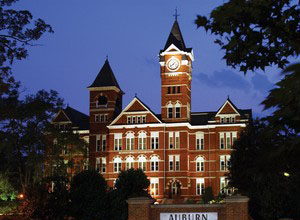 History
History
Auburn University began as East Alabama Male College, which was chartered in 1856 and opened its doors in 1859 as a private liberal arts institution. In 1872, legal control of the institution was transferred to the state, making it the first land-grant college in the South to be established separate from the state university. It thus became the Agricultural and Mechanical College of Alabama.
In 1899, the name was again changed to the Alabama Polytechnic Institute. In 1960, the school officially acquired the name it has long been called and one more in keeping with its location, size, and mission — Auburn University.
CCTS Partnership
As a CCTS partner, Auburn provides investigative expertise through imaging, translational animal models, clinical pharmacy, drug development, and population outcomes research. Auburn has world-class 3T and 7T MR imaging facilities that are available for research services. A number of other imaging modalities for research animals are available through ALIAS, the Auburn Laboratory for Imaging Animal Systems. Auburn’s College of Veterinary Medicine recently opened a new small animal teaching hospital, currently the largest in the western hemisphere. Auburn has numerous programs that support clinical translation, such as AURIC (the Auburn University Research Initiative in Cancer). A common thread running throughout translation research at Auburn is “one health”. This approach views the discoveries made treating one species as applicable in other species. This combination of research resources and approaches makes Auburn uniquely positioned to enable breakthroughs in clinical and translational science that are simply not possible at the majority of research institutions across the country.
Auburn has an active approach to undergraduate and graduate education. Students at Auburn participate in the training mission with engineering design teams and mini-sabbaticals. As part of the CCTS Training Academy, Auburn participates in panes, the TL1 and KL2 training programs, the K writing club, ethics training, TIERS, and Secondary Data Analysis/Research Methods and offers mini-sabbaticals.
Current research projects at Auburn focus on brain imaging, cardiovascular imaging, functional MRI, MR spectroscopy and a 7T MRI study of cervical spine remodeling in response to constraint-induced therapy in high spinal cord injury patients, numerous investigations into targeting drugs to specific tissues and tumors, precision based medicine approaches to tailoring treatment to the molecular signature of disease, and numerous clinical trials including studies of head/neck cancer therapeutics and the use of oncolytic viruses to treat osteosarcoma, both in dogs.
Clinical, translational, and outreach activities of the CCTS benefit from Auburn University Harrison School of Pharmacy (HSOP) clinical faculty, who participate in patient care and research activities at sites throughout Alabama. Similarly, HSOP health outcomes faculty contribute to the drug safety and efficacy research expertise of the CCTS. Furthermore, the addition of the new Pharmaceutical Sciences Research Building, slated to open in Summer 2017, will provide a novel locus for translational research activity led by faculty from the HSOP Department of Drug Discovery and Development.
To learn more about the research initiatives and resources at Auburn University, click here.
